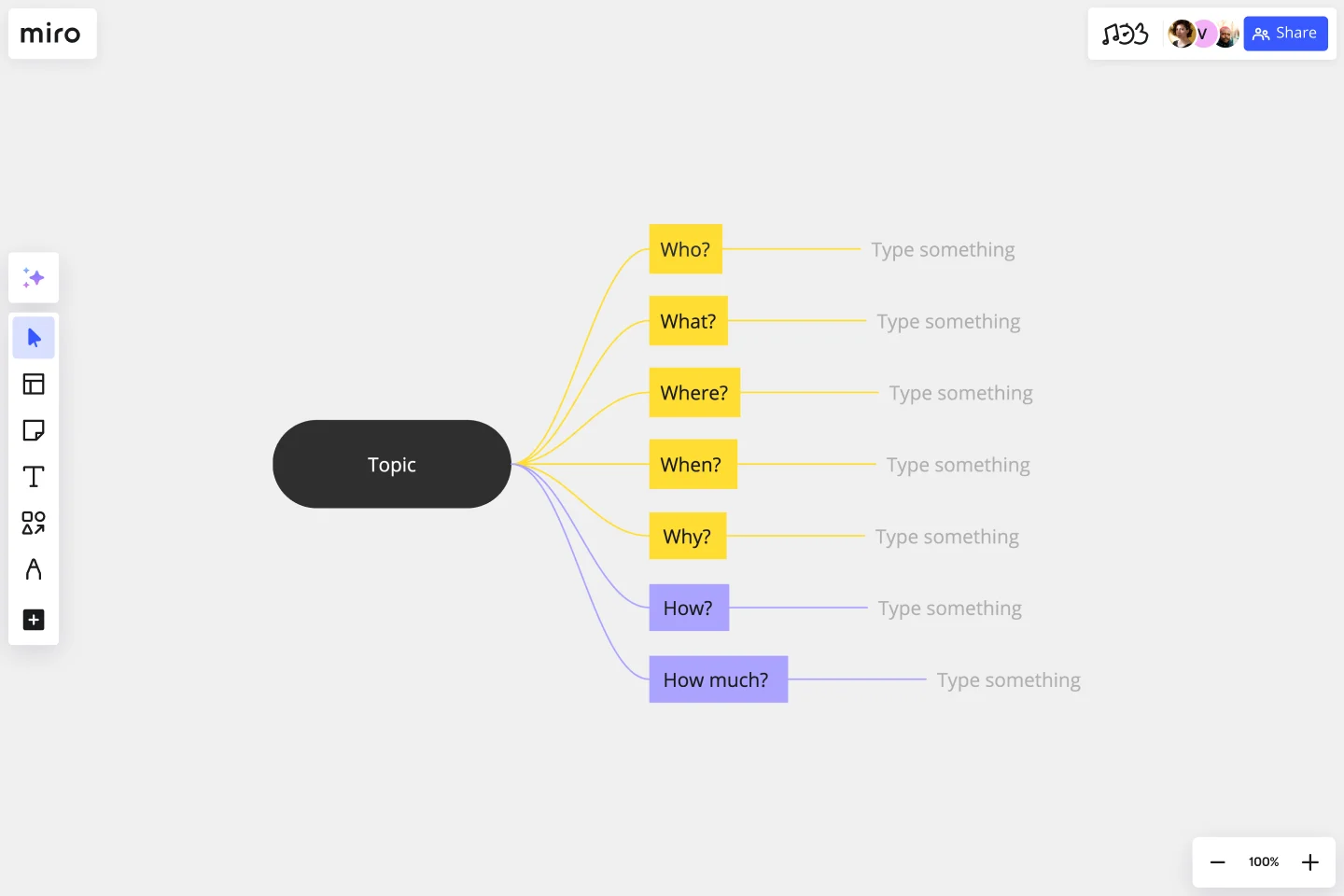5W2H Template
Explore a structured approach to project management addressing the who, what, when, where, why, how, and how much with the 5W2H template.
About the 5W2H Template
The 5W2H framework is a valuable tool that can help you streamline your thought process and improve your project management skills. This structured approach involves answering seven questions that can help you gather and organize information effectively.
The questions are: Who, What, When, Where, Why, How, and How Much. You can make informed decisions and achieve better outcomes by examining a situation comprehensively.
What: Identify the core task or issue.
Why: Understand the purpose or motive behind it.
Who: Pinpoint the people or teams involved.
When: Establish the timeline and deadlines.
Where: Specify the location or context.
How: Explore the methods or processes.
How Much: Determine the resources or quantities involved.
This template is a guiding framework, ensuring no crucial aspect is overlooked.
How to use the 5W2H Template in Miro
Edit easily: Customize the template effortlessly by filling in relevant details or changing the questions.
Expand with a click: Effortlessly expand the template to explore details with a single click, providing a deeper dive into each element.
Add contextual artifacts: Enhance your board by incorporating documents, images, or other artifacts that provide additional context to your 5W2H analysis.
Why should you use a 5W2H Template?
1. Clarity and focus: The template provides a structured approach, helping teams clarify objectives and focus on key aspects.
2. Efficient problem solving: the 5W2H template facilitates thorough problem analysis and effective solutions by addressing all relevant questions.
3. Improved communication: Enhance communication within teams by ensuring that everyone is on the same page regarding project details.
4. Time management: Clearly defined timelines and deadlines ensure better time management, reducing delays and improving project efficiency.
5. Comprehensive understanding: The template encourages a thorough understanding of a situation, minimizing the risk of overlooking critical details.
Is the 5W2H template suitable for all types of projects?
Yes, the template's versatility makes it applicable to various projects, from simple tasks to complex problem-solving scenarios.
How can I get all crucial information when using the template?
The structured nature of the 5W2H template guides you through each essential question, reducing the likelihood of overlooking key details.
Get started with this template right now.
Project Charter Template
Works best for:
Project Management, Documentation, Strategic Planning
Project managers rely on project charters as a source of truth for the details of a project. Project charters explain the core objectives, scope, team members and more involved in a project. For an organized project management, charters can be useful to align everyone around a shared understanding of the objectives, strategies and deliverables for a project of any scope. This template ensures that you document all aspects of a project so all stakeholders are informed and on the same page. Always know where your project is going, its purpose, and its scope.
Lean UX Canvas Template
Works best for:
Desk Research, Product Management, User Experience
What are you building, why are building it, and who are you building it for? Those are the big pictures questions that guide great companies and teams toward success — and Lean UX helps you find the answers. Especially helpful during project research, design, and planning, this tool lets you quickly make product improvements and solve business problems, leading to a more customer-centric product. This template will let you create a Lean UX canvas structured around eight key elements: Business problem, Business outcome, Users and customers, User benefits, Solution ideas, Hypothesis, Assumptions, Experimentation.
Checklist Template
Works best for:
Project Management, Task Management
The Checklist Template is designed to organize and track tasks visually, offering workflow clarity. A key benefit of using this template is its potential to amplify collaboration, ensuring that all team members remain aligned and informed, paving the way for efficient project completion.
PI Planning Template
Works best for:
PI Planning, Product Management
The Miro PI Planning Template streamlines the Program Increment planning process for Agile teams. It facilitates a collaborative environment, enabling teams to efficiently align on strategies, identify dependencies, and convert decisions into actionable tasks. With features like real-time collaboration, Jira integration, and a centralized workspace, the template supports teams in enhancing efficiency, engagement, and decision-making.
Project Canvas Template
Works best for:
Project Management, Documentation, Project Planning
A project canvas is a management tool that helps you summarize, visualize, and share all necessary information about your project. It can be used by all team members—from facilitators to project management professionals—at every stage of project development. The project canvas template allows you to keep all stakeholders in the project development process in the loop. By using a single platform for all project-related discussions, you can build a clear project overview and improve collaboration.
Healthcare Service Journey Transformation Template
Works best for:
Service Blueprint
Improve patient experiences with the Healthcare Service Journey template. This tool helps you map out every step of the patient journey, identifying key touchpoints and potential pain points. Use it to enhance service delivery, streamline processes, and ensure a patient-centered approach. Ideal for healthcare providers seeking to improve service quality and patient satisfaction.
